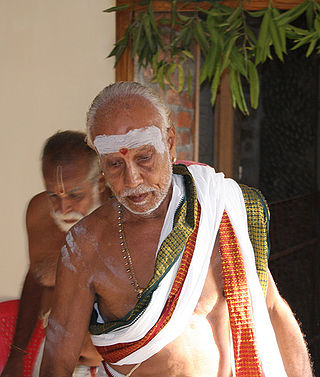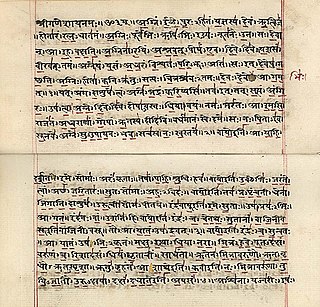
The Brahmanas are Vedic śruti works attached to the Samhitas of the Rig, Sama, Yajur, and Atharva Vedas. They are a secondary layer or classification of Sanskrit texts embedded within each Veda, which explain and instruct on the performance of Vedic rituals. In addition to explaining the symbolism and meaning of the Samhitas, Brahmana literature also expounds scientific knowledge of the Vedic Period, including observational astronomy and, particularly in relation to altar construction, geometry. Divergent in nature, some Brahmanas also contain mystical and philosophical material that constitutes Aranyakas and Upanishads.
The Aranyakas are a part of the ancient Indian Vedas concerned with the meaning of ritual sacrifice. They typically represent the later sections of the Vedas, and are one of many layers of Vedic texts. The other parts of the Vedas are the Samhitas, Brahmanas (commentary), and the Upanishads.

Iyers are an ethnoreligious community of Tamil-speaking Hindu Brahmins. Most Iyers are followers of the Advaita philosophy propounded by Adi Shankara and adhere to the Smarta tradition. This is in contrast to the Iyengar community, who are adherents of Sri Vaishnavism. The Iyers and the Iyengars are together referred to as Tamil Brahmins. The majority of Iyers reside in Tamil Nadu, India.

Yajna in Hinduism refers to any ritual done in front of a sacred fire, often with mantras. Yajna has been a Vedic tradition, described in a layer of Vedic literature called Brahmanas, as well as Yajurveda. The tradition has evolved from offering oblations and libations into sacred fire to symbolic offerings in the presence of sacred fire (Agni).
The Atharvaveda or Atharva Veda or Atharvana Veda is the "knowledge storehouse of atharvāṇas, the procedures for everyday life". The text is the fourth Veda, and is a late addition to the Vedic scriptures of Hinduism.

The Yajurveda is the Veda primarily of prose mantras for worship rituals. An ancient Vedic Sanskrit text, it is a compilation of ritual-offering formulas that were said by a priest while an individual performed ritual actions such as those before the yajna fire. Yajurveda is one of the four Vedas, and one of the scriptures of Hinduism. The exact century of Yajurveda's composition is unknown, and estimated by Witzel to be between 1200 and 800 BCE, contemporaneous with Samaveda and Atharvaveda.
Trivedi is a family name from northern and western India reflecting the mastery over three of the four vedas. In Sanskrit Trivedi means 'one that knows the three Vedas’, from tri = 'three' + veda ‘(sacred) knowledge' leading to vedi = 'to see'. Similar family names are Chaturvedi and Dwivedi. They are also known as Tripathi and Tiwari in some parts of north India.

The Vedas are a large body of religious texts originating in ancient India. Composed in Vedic Sanskrit, the texts constitute the oldest layer of Sanskrit literature and the oldest scriptures of Hinduism.

The Brihadaranyaka Upanishad is one of the Principal Upanishads and one of the first Upanishadic scriptures of Hinduism. A key scripture to various schools of Hinduism, the Brihadaranyaka Upanisad is tenth in the Muktikā or "canon of 108 Upanishads".
Deshastha Brahmin is a Hindu Brahmin subcaste mainly from the Indian state of Maharashtra and North Karnataka. Other than these states, according to authors K. S. Singh, Gregory Naik and Pran Nath Chopra, Deshastha Brahmins are also concentrated in the states of Telangana (which was earlier part of Hyderabad State and Berar Division), Andhra Pradesh and Madhya Pradesh (Which was earlier part of Central Provinces and Berar) Historian Pran Nath Chopra and journalist Pritish Nandy say, "Most of the well-known saints from Maharashtra, Karnataka and Andhra Pradesh were Deshastha Brahmins". The mother tongue of Deshastha Brahmins is either Marathi, Kannada or Telugu.

The Isha Upanishad, also known as Shri Ishopanishad, Ishavasya Upanishad, or Vajasaneyi Samhita Upanishad, is one of the shortest Upanishads, embedded as the final chapter (adhyāya) of the Shukla Yajurveda. It is a Mukhya Upanishad, and is known in two recensions, called Kanva (VSK) and Madhyandina (VSM). The Upanishad is a brief poem, consisting of 17 or 18 verses, depending on the recension.
A shakha is a Hindu theological school that specializes in learning certain Vedic texts, or else the traditional texts followed by such a school. An individual follower of a particular school or recension is called a śākhin. The term is also used in Hindu philosophy to refer to an adherent of a particular orthodox system.
Shiksha is a Sanskrit word, which means "instruction, lesson, learning, study of skill". It also refers to one of the six Vedangas, or limbs of Vedic studies, on phonetics and phonology in Sanskrit.
Kanva or Kanwa, also called Karnesh, was an ancient Hindu rishi of the Treta Yuga, to whom some of the hymns of the Rig Veda are ascribed. He was one of the Angirasas. He has been called a son of Ghora, but this lineage belongs to Pragatha Kanva, a subsequent Kanva of which there were many. However, Puranic literature has other different lineages for him, one as the son of Apratiratha and grandson of King Matinara, and another as the son of Ajamidha, who was a descendant in the ninth generation of Tansu, the brother of Apratiratha (Atiratha), or Ajamidha who was a contemporary of Matinara. This last seems to be the modern consensus. He is sometimes included in the list of the seven sages . Kanva had a son Medhatithi. Kanva is also mentioned in Mahabharata as the adoptive father of Shakuntala.
The Taittirīya Shakha, is a shakha of the Krishna (black) Yajurveda. Most prevalent in South India, it consists of the Taittirīya Samhita ('TS'), Taittirīya Brahmana ('TB'), Taittirīya Aranyaka ('TA'), and Taittirīya Pratisakhya ('TP').

Parwar, also spelt as Paravāra, is a major Jain community from the Bundelkhand region, which is largely in Madhya Pradesh, but also includes the two districts of Lalitpur and Jhansi in Uttar Pradesh. Apart from them, Nagpur district (Maharashtra) have also a very large Parwar community. There is an area in Itwari of Nagpur known as Parwar-Pura having large number of Parwar's homes and shops. Most of the Nagpur's Parwar are migrated from Sagar, Deori, and other small villages of Sagar District of MP. Parwar exclusively follow the Digambar Jain tradition. Parwar usually preferred their marriage within community. There are 12 Gotra in Parwar community. Each Gotra has 12 Moor (lineages). A marriage within the same gotra or lineage are not allowed. Traditionally a marriage within any of the 8 branches was not permitted and hence the community was termed ashta-shakha.
Kāṇva Shākha is the oldest shakha of Shukla Yajurveda. The Kānva tradition is followed mostly in Tamil Nadu, Orissa, Karnataka, parts of Maharashtra, Madhya Pradesh, Gujarat and Andhra Pradesh. The Kānva Shākha was quite prevalent around the period of Shankaracharya's birth. The paramparaāchārya for Shukla Yajurveda was sage Yajnavalkya.

The Rigveda or Rig Veda is an ancient Indian collection of Vedic Sanskrit hymns (sūktas). It is one of the four sacred canonical Hindu texts (śruti) known as the Vedas. Only one Shakha of the many survive today, namely the Śakalya Shakha. Much of the contents contained in the remaining Shakhas are now lost or are not available in the public forum.

The Samaveda, is the Veda of melodies and chants. It is an ancient Vedic Sanskrit text, and is one of the sacred scriptures in Hinduism. One of the four Vedas, it is a liturgical text which consists of 1,875 verses. All but 75 verses have been taken from the Rigveda. Three recensions of the Samaveda have survived, and variant manuscripts of the Veda have been found in various parts of India.

The Yajnavalkya Upanishad is a late medieval era Sanskrit text and a minor Upanishad of Hinduism. The text is attached to the Shukla Yajurveda, and is one of the 20 Sannyasa (renunciation) Upanishads.











